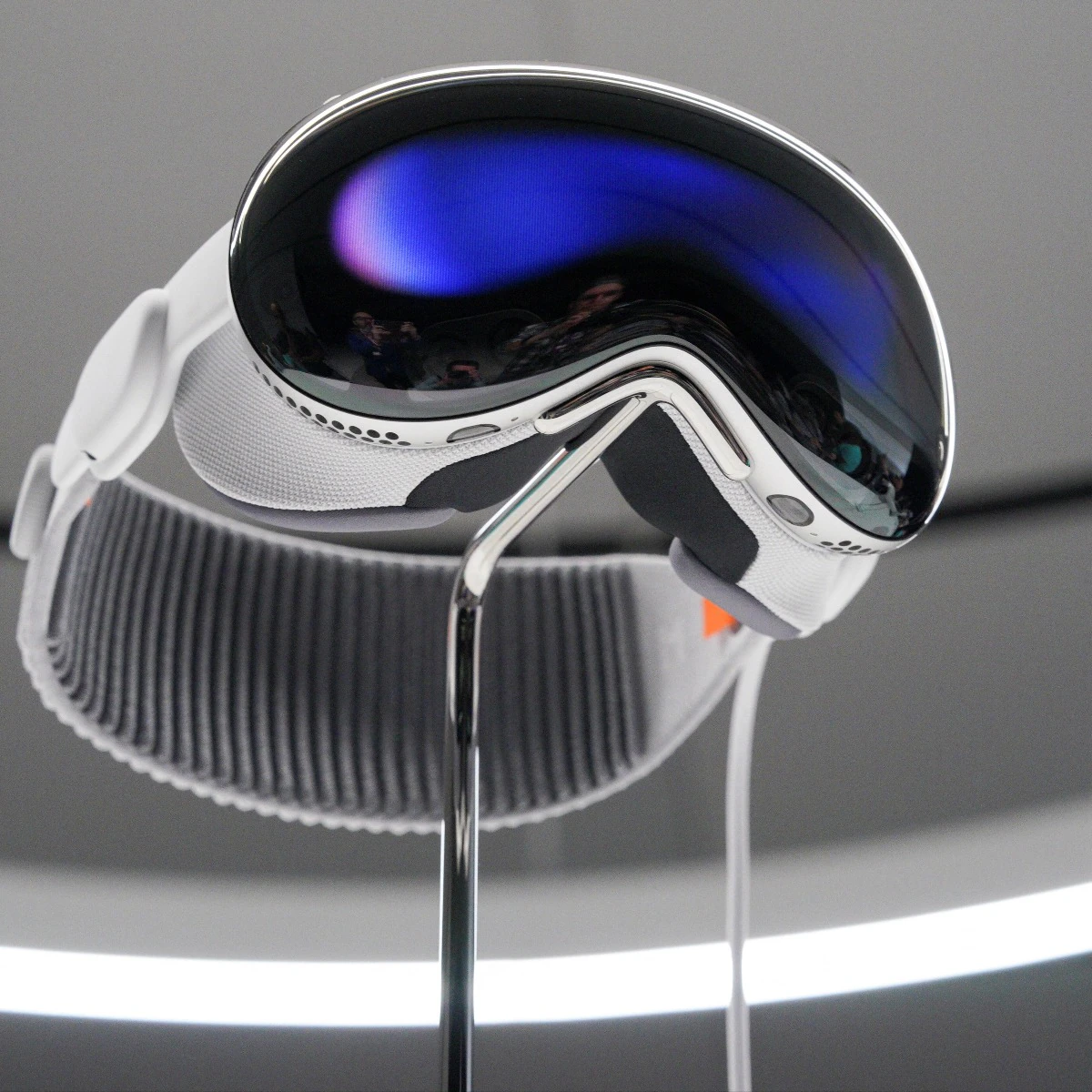Apple Unveils Vision Pro in India
Posted On July 11, 2025

Apple Launches Vision Pro in India, Ushering in a New Era of Spatial Computing
In a move that marks a new chapter in immersive technology adoption across South Asia, Apple has officially launched its highly anticipated Vision Pro headset in India. The spatial computing device, first unveiled in the United States in early 2024, has now made its way to Indian shores amid much anticipation from tech enthusiasts, developers, and enterprise users. This expansion signals Apple’s commitment to establishing India not just as a consumer market but as a vital innovation hub in the emerging field of extended reality (XR).
The Apple Vision Pro is unlike anything Apple has released before - neither a phone, nor a computer, nor just another wearable. It is a standalone mixed-reality headset designed to bridge the physical and digital worlds. The device enables users to interact with apps, content, and data in a fully immersive 3D environment, using eye tracking, gesture control, and voice commands - no physical controller required. Priced at around ₹3,00,000, the headset is undoubtedly a premium offering, but it introduces Indian consumers to an entirely new way of computing, where screens float in midair and digital interfaces wrap around the user’s real-world space.
What sets the Vision Pro apart is not just its hardware power - powered by Apple’s M2 chip alongside a dedicated R1 chip for real-time sensor processing - but also its groundbreaking software platform, visionOS. Designed from the ground up, visionOS allows developers to create spatial apps that transcend the boundaries of traditional screens. From productivity tools like immersive spreadsheets to creative apps that let designers build 3D models in virtual space, the Vision Pro is pitched as a device for creators, professionals, and future-focused consumers alike. With micro-OLED displays offering a combined resolution greater than a 4K TV per eye, and spatial audio that mimics real-world acoustics, it delivers one of the most visually and sonically rich computing experiences currently available.
For Indian developers, the launch opens up new opportunities. Apple has already begun collaborating with select startups, game developers, and educational institutions across Bengaluru, Hyderabad, and Pune to create native spatial applications optimized for the Indian market. Local developers are reportedly experimenting with AR-powered virtual museum tours, immersive educational content in regional languages, and spatial health applications for physiotherapy and diagnostics. Apple is also organizing Vision Pro Labs in Mumbai and Delhi, offering hands-on demos, workshops, and developer onboarding sessions to foster innovation on the platform.
From a market strategy perspective, Apple’s decision to bring the Vision Pro to India is both ambitious and forward-looking. India represents one of the fastest-growing tech markets globally, with a digitally savvy population and a robust developer ecosystem. While the Vision Pro’s high price tag limits its accessibility for the average consumer, Apple appears to be targeting a more strategic demographic- enterprise clients, software developers, creative professionals, and luxury tech adopters. In sectors like healthcare, architecture, education, design, and remote collaboration, spatial computing can offer significant productivity gains - and Apple is betting that Indian industries are ready to explore that potential.
Public reception has been a mix of awe and curiosity. Early reviewers in India have praised the Vision Pro’s crystal-clear optics, seamless hand tracking, and natural integration of real and virtual elements. However, concerns remain around comfort for extended wear, battery life, and the lack of India-specific content at launch. Apple has addressed some of these concerns by promising more regional content, language support, and tailored apps in upcoming software updates. The recently announced visionOS 2, expected to roll out later this year, brings enhancements like spatial photo editing, advanced collaboration tools, and improved support for multilingual interaction - all of which could appeal to Indian professionals and creators.
Apple has also taken steps to make the Vision Pro experience accessible to potential buyers before they commit to the steep price. Interactive demo zones have been set up in Apple BKC (Mumbai) and Apple Saket (Delhi), where visitors can schedule guided walkthroughs of the Vision Pro’s capabilities. These demos showcase not only entertainment content like immersive movies and panoramic video but also productivity use cases such as multitasking in a floating virtual workspace, navigating maps in 3D, and attending FaceTime calls with life-sized avatars.
Looking ahead, Apple is reportedly already working on a lighter, more affordable version of the Vision Pro, which could launch globally within the next two years. Industry analysts speculate that this version, unofficially dubbed "Vision Lite" or "Vision SE," will retain the core spatial experience while sacrificing some of the premium materials and hardware specifications to bring the price down by at least 30-40%. For India, this could mark the turning point where spatial computing shifts from an elite novelty to a mainstream platform - particularly in fields like education, virtual training, and creative design.
The arrival of Vision Pro in India is more than a product launch - it is a signal that Apple sees spatial computing as the next frontier, and it intends to shape that future with India playing an active role. By giving developers the tools to build immersive apps and helping industries rethink their workflows, Apple is planting the seeds for a spatial ecosystem that could eventually transform how Indians work, learn, and communicate. Though still in its early phase, the Vision Pro’s presence in India is poised to spark a new wave of digital transformation - one where reality and imagination no longer live on opposite sides of a screen.
In a move that marks a new chapter in immersive technology adoption across South Asia, Apple has officially launched its highly anticipated Vision Pro headset in India. The spatial computing device, first unveiled in the United States in early 2024, has now made its way to Indian shores amid much anticipation from tech enthusiasts, developers, and enterprise users. This expansion signals Apple’s commitment to establishing India not just as a consumer market but as a vital innovation hub in the emerging field of extended reality (XR).
The Apple Vision Pro is unlike anything Apple has released before - neither a phone, nor a computer, nor just another wearable. It is a standalone mixed-reality headset designed to bridge the physical and digital worlds. The device enables users to interact with apps, content, and data in a fully immersive 3D environment, using eye tracking, gesture control, and voice commands - no physical controller required. Priced at around ₹3,00,000, the headset is undoubtedly a premium offering, but it introduces Indian consumers to an entirely new way of computing, where screens float in midair and digital interfaces wrap around the user’s real-world space.
What sets the Vision Pro apart is not just its hardware power - powered by Apple’s M2 chip alongside a dedicated R1 chip for real-time sensor processing - but also its groundbreaking software platform, visionOS. Designed from the ground up, visionOS allows developers to create spatial apps that transcend the boundaries of traditional screens. From productivity tools like immersive spreadsheets to creative apps that let designers build 3D models in virtual space, the Vision Pro is pitched as a device for creators, professionals, and future-focused consumers alike. With micro-OLED displays offering a combined resolution greater than a 4K TV per eye, and spatial audio that mimics real-world acoustics, it delivers one of the most visually and sonically rich computing experiences currently available.
For Indian developers, the launch opens up new opportunities. Apple has already begun collaborating with select startups, game developers, and educational institutions across Bengaluru, Hyderabad, and Pune to create native spatial applications optimized for the Indian market. Local developers are reportedly experimenting with AR-powered virtual museum tours, immersive educational content in regional languages, and spatial health applications for physiotherapy and diagnostics. Apple is also organizing Vision Pro Labs in Mumbai and Delhi, offering hands-on demos, workshops, and developer onboarding sessions to foster innovation on the platform.
From a market strategy perspective, Apple’s decision to bring the Vision Pro to India is both ambitious and forward-looking. India represents one of the fastest-growing tech markets globally, with a digitally savvy population and a robust developer ecosystem. While the Vision Pro’s high price tag limits its accessibility for the average consumer, Apple appears to be targeting a more strategic demographic- enterprise clients, software developers, creative professionals, and luxury tech adopters. In sectors like healthcare, architecture, education, design, and remote collaboration, spatial computing can offer significant productivity gains - and Apple is betting that Indian industries are ready to explore that potential.
Public reception has been a mix of awe and curiosity. Early reviewers in India have praised the Vision Pro’s crystal-clear optics, seamless hand tracking, and natural integration of real and virtual elements. However, concerns remain around comfort for extended wear, battery life, and the lack of India-specific content at launch. Apple has addressed some of these concerns by promising more regional content, language support, and tailored apps in upcoming software updates. The recently announced visionOS 2, expected to roll out later this year, brings enhancements like spatial photo editing, advanced collaboration tools, and improved support for multilingual interaction - all of which could appeal to Indian professionals and creators.
Apple has also taken steps to make the Vision Pro experience accessible to potential buyers before they commit to the steep price. Interactive demo zones have been set up in Apple BKC (Mumbai) and Apple Saket (Delhi), where visitors can schedule guided walkthroughs of the Vision Pro’s capabilities. These demos showcase not only entertainment content like immersive movies and panoramic video but also productivity use cases such as multitasking in a floating virtual workspace, navigating maps in 3D, and attending FaceTime calls with life-sized avatars.
Looking ahead, Apple is reportedly already working on a lighter, more affordable version of the Vision Pro, which could launch globally within the next two years. Industry analysts speculate that this version, unofficially dubbed "Vision Lite" or "Vision SE," will retain the core spatial experience while sacrificing some of the premium materials and hardware specifications to bring the price down by at least 30-40%. For India, this could mark the turning point where spatial computing shifts from an elite novelty to a mainstream platform - particularly in fields like education, virtual training, and creative design.
The arrival of Vision Pro in India is more than a product launch - it is a signal that Apple sees spatial computing as the next frontier, and it intends to shape that future with India playing an active role. By giving developers the tools to build immersive apps and helping industries rethink their workflows, Apple is planting the seeds for a spatial ecosystem that could eventually transform how Indians work, learn, and communicate. Though still in its early phase, the Vision Pro’s presence in India is poised to spark a new wave of digital transformation - one where reality and imagination no longer live on opposite sides of a screen.









.webp)